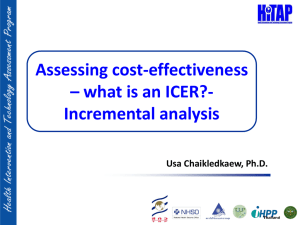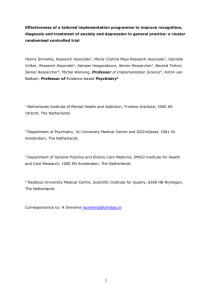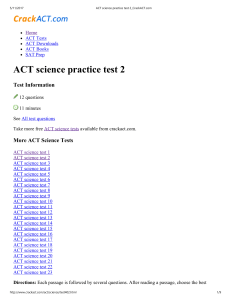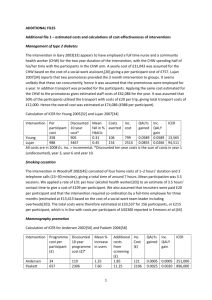Q1. To determine the cost-effectiveness of an intervention A
advertisement
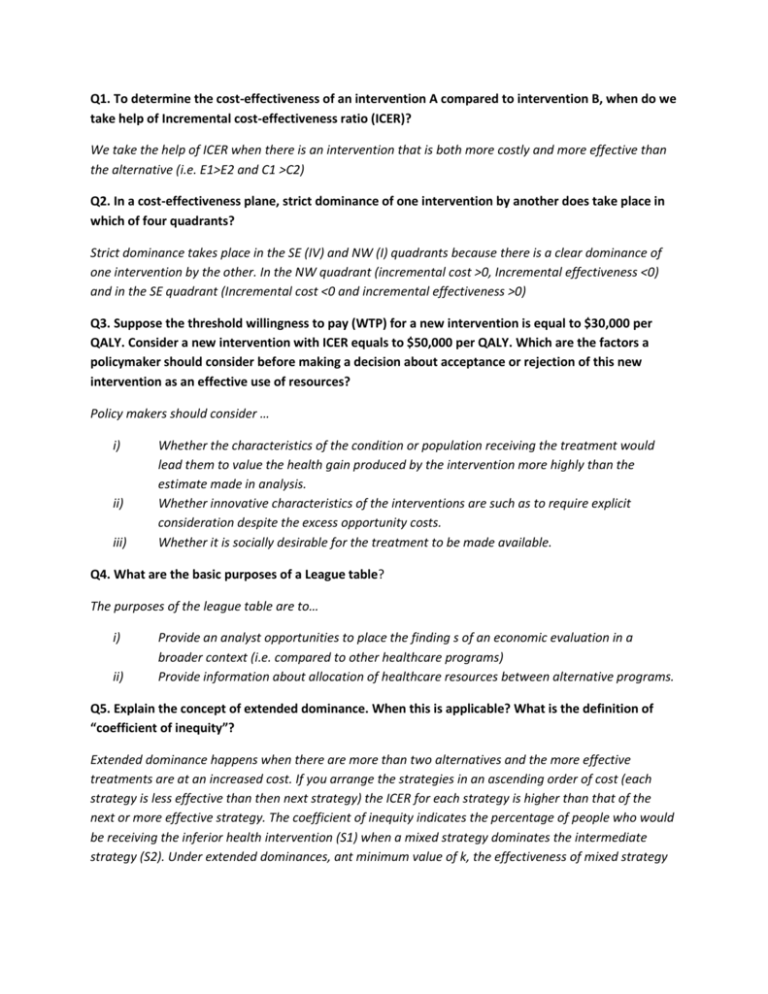
Q1. To determine the cost-effectiveness of an intervention A compared to intervention B, when do we take help of Incremental cost-effectiveness ratio (ICER)? We take the help of ICER when there is an intervention that is both more costly and more effective than the alternative (i.e. E1>E2 and C1 >C2) Q2. In a cost-effectiveness plane, strict dominance of one intervention by another does take place in which of four quadrants? Strict dominance takes place in the SE (IV) and NW (I) quadrants because there is a clear dominance of one intervention by the other. In the NW quadrant (incremental cost >0, Incremental effectiveness <0) and in the SE quadrant (Incremental cost <0 and incremental effectiveness >0) Q3. Suppose the threshold willingness to pay (WTP) for a new intervention is equal to $30,000 per QALY. Consider a new intervention with ICER equals to $50,000 per QALY. Which are the factors a policymaker should consider before making a decision about acceptance or rejection of this new intervention as an effective use of resources? Policy makers should consider … i) ii) iii) Whether the characteristics of the condition or population receiving the treatment would lead them to value the health gain produced by the intervention more highly than the estimate made in analysis. Whether innovative characteristics of the interventions are such as to require explicit consideration despite the excess opportunity costs. Whether it is socially desirable for the treatment to be made available. Q4. What are the basic purposes of a League table? The purposes of the league table are to… i) ii) Provide an analyst opportunities to place the finding s of an economic evaluation in a broader context (i.e. compared to other healthcare programs) Provide information about allocation of healthcare resources between alternative programs. Q5. Explain the concept of extended dominance. When this is applicable? What is the definition of “coefficient of inequity”? Extended dominance happens when there are more than two alternatives and the more effective treatments are at an increased cost. If you arrange the strategies in an ascending order of cost (each strategy is less effective than then next strategy) the ICER for each strategy is higher than that of the next or more effective strategy. The coefficient of inequity indicates the percentage of people who would be receiving the inferior health intervention (S1) when a mixed strategy dominates the intermediate strategy (S2). Under extended dominances, ant minimum value of k, the effectiveness of mixed strategy will be equal to intermediate strategy. Similarly at the maximum possible value of k, the cost of the mixed strategy will be equal to the cost of strategy S2. Q6. What is the major objective of conducting a Cost Minimization Analysis (CMA)? Why it is not ideal to conduct a CMA? The major objective of a cost minimization analysis is to compare two programs that have the same consequences or effectiveness, but different costs. Hence, the program with less cost would be favored. It is not ideal to conduct CMA because costs and consequences always have some degree of uncertainty, making them impossible to design in advance. Q7. What are the characteristics of a full economic evaluation? How do those differ from the characteristics of a partial economic evaluation? A full economic evaluation includes a comparison of 2 or more alternatives and both costs and consequences of the alternatives are examined. A partial economic evaluation includes outcomes description only or description of costs only, both which may or may not have a comparison of 2 more more alternatives. It can also include a comparison of two or more alternatives, but it may or may not include both costs and consequences at the same time. Q8. What are the major objectives of conducting a Cost of Illness study? The major objectives of conducting a cost of illness study is to consider all costs of a particular disease that includes that total burden of a particular disease on the society (i.e. pain and suffering, mortality costs, costs due to absenteeism, informal care costs) Q9. If a study is conducted from societal perspective, is it required to include transfer payments in cost estimation? Explain. Transfer payments (i.e. social security, medicare) only represent a shift in resources, not the use of them, therefore it’s not included in cost estimation). Q10. What are the major problems with piggyback economic evaluation? Patients are hand-picked (selected study subjects) and instead of everyday physicians, blinded investigators are involved. This is not representative of real-=life clinical practice. Efforts to increase internal validity of a clinical trial may actually undermine the economic evaluation. Q11. List the two major sources for collecting data on resource utilization in piggyback economic revaluations. What are advantages and disadvantages of each of those methods? o Patient Medical Records (+) Provide accurate data on resource utilization Minimal burden on patients (-)Require patient consent and need to maintain patient confidentiality May be incompletes Lack of data on non-medical resources and indirect costs Record keeping/ coding may not be standardized across centers. o Patient Diaries/Interviews (+) High level of detail possible Can provide data on non-medical resource use and indirect costs (-)Recall-bias Patient’s lack of knowledge regarding the services they receive Non compliance with diaries hinder data collection Costly and burdensome on patients Q12. What is the fundamental difference between a confidence box and a confidence ellipse? Confidence ellipse assumes that there is a covariance between costs and effectiveness and confidence box does not. Q13. How does the correlation between difference in cost and difference in effectiveness impact the variance of ICER? The variance (hence uncertainty of the estimate of ICER increase as the variance of the difference in mean cost between two groups increase. The variance of the estimate of ICER increases as the variance of the difference in mean effectiveness between the two groups increases. As the difference in population mea cost between two groups increases, the variance of ICER also increase. If the correlation between cost and effectiveness is negative, than the variance of ICER also decreases. If the correlation between cost and effectiveness is positive, then the variance of ICER also decreases. Q14. What are the steps of developing a 95% CI of ICER using a Bootstrapping method? Is bootstrapping a parametric procedure? i) ii) Create a large number of bootstrap resample Calculate the mean for each of these resamples iii) iv) v) Sample with replacement nt ( number of observations form the tx group) and use these to calculate replicate of mean costs (Ct) and a bootstrap replicate of mean effectiveness for treatment group. Similarly, sample with replacement nc (number of observations in the control group) cost/effect pairs from the control group and use these to calculate a bootstrap replicate of mean cost and a bootstrap replicate of mean effectiveness for the control group. Calculate a bootstrap replicate of ICER estimated based on each sample. The bootstrap replicate of ICER is calculated using a formula. The process of sampling with replacement is conducted an large number of times Q15. What are the advantages of using a Net benefit framework over ICER approach? The advantages of using net benefit approach are…. 1) Allows one to interpret a negative ICER estimate 2) Ant intervention’s attractiveness decreases monotonically as the incremental costs of implementing the program increase (holding effectiveness constant) and increases monotonically as the incremental effectiveness (holding cost constant). In contrast, the direction of change ( increase or decrease ) in CER associated with a change in C depends on the sign of E and the direction of change in CER associate with a change in E depends inversely on the sign of C. 3) Since, ICER is a ratio, while net monetary benefit is just a linear expression, from a statistical viewpoint it is easier to work with the sampling distributing of net monetary benefit compared to ICER. The variance of net monetary benefit is easy to determine. The statistical convenience of net benefit statistic also helps to determine the appropriate same size for a trial -based evaluation. Q16. How does a cost-effectiveness acceptability curve help a policymaker in decision making? The cost-effectiveness acceptability curve shows graphically the probability that a particular intervention is optimal over a range of values of the cost-effectiveness ration threshold. It shows a decision-maker the probability that, if the intervention is funded or reimbursed, this will be the correct decision.


